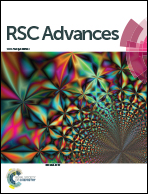One-step preparation of graphene oxide–poly(3,4 ethylenedioxythiophene) composite films for nonvolatile rewritable memory devices†
Abstract
Nonvolatile rewritable memory devices were fabricated from the composite films of poly(3,4-ethylenedioxythiophene) (PEDOT) grown on a graphene oxide (GO) substrate. Photopolymerization which used GO as the reaction initiator was carried out for preparing the GO–PEDOT composite films of the bilayer structure. The composite films were analyzed by specular reflection infrared spectroscopy, Raman, atomic force microscopy, field-emission scanning electron microscopy coupled with energy-dispersive X-ray analysis and thermogravimetric analysis. The electronic properties of the as-prepared GO–PEDOT composite films were revealed by solid-phase ultraviolet photoelectron spectroscopy and X-ray photoelectron spectroscopy. Fabricated from the composite films, the ITO/GO–PEDOT/Al device exhibits nonvolatile rewritable memory of high performance with an ON/OFF current ratio of 3 × 104 and turn-on voltage of 1.5 V. The current–voltage characteristics and resistance–temperature dependence at different resistance levels are discussed. The resistance of the OFF state presents negative temperature dependence, indicating a typical semiconductor property. The resistance of the ON state is found to increase with increasing temperature, indicating a metallic behavior.



 Please wait while we load your content...
Please wait while we load your content...